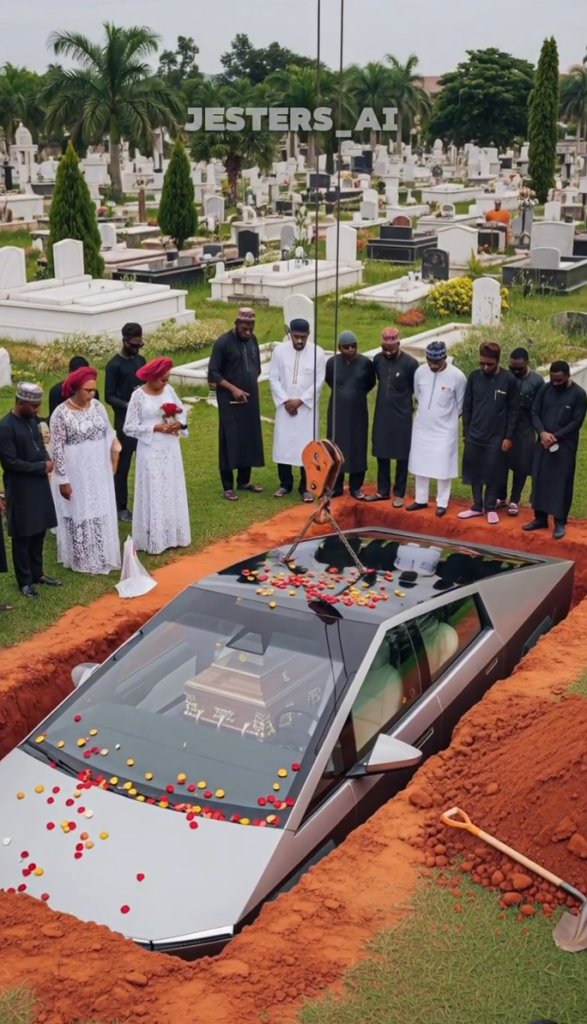The air hung heavy with the scent of freshly turned earth and exotic floral arrangements. But this was no ordinary funeral. In the sprawling, meticulously manicured grounds of the Vance family cemetery, a massive, rectangular pit had been dug, unlike any grave seen before. And into it, suspended by a powerful crane, was slowly descending not a traditional coffin, but a sleek, angular, silver vehicle – a bespoke, one-of-a-kind electric hypercar, its futuristic lines gleaming under the morning sun.
This was the final farewell for Elias Vance, the enigmatic tech titan and visionary behind ‘Aether Dynamics,’ a company that had revolutionized sustainable energy and autonomous transportation. Elias had always been ahead of his time, a man who saw the future and built it with his own hands. And in death, he remained true to his unconventional spirit.
The mourners, a mix of family, former colleagues, and curious onlookers, stood in stunned silence. Dressed in elegant black and white, they watched as the car, Elias’s most cherished personal project, his ‘Chariot of Tomorrow,’ was lowered into the earth. Rose petals, crimson and white, rained down upon its glass roof, scattering like jewels.
Elias Vance had been many things: a genius, a recluse, a philanthropist, and an obsessive perfectionist. But above all, he was a futurist. He believed that the human spirit, like technology, was meant to evolve, to transcend its earthly bounds. And his ‘Chariot of Tomorrow,’ a vehicle he had designed himself, was not just a car; it was a testament to his life’s philosophy. It was fully autonomous, powered by a revolutionary cold-fusion engine he had secretly developed, and built with materials that were said to be stronger than steel, lighter than air.
His last will and testament, read with a mixture of shock and amusement by his bewildered lawyers, had been explicit: he was to be interred not in a casket, but within his ‘Chariot of Tomorrow.’ “Let my final journey be as innovative as my life,” the will had stated, “and let my vessel carry me into the next great unknown, a symbol of humanity’s unending quest for progress.”
His family, initially horrified, had eventually conceded. Elias had always been a man who got what he wanted, even from beyond the grave. And so, after weeks of legal wrangling and engineering feats to ensure the structural integrity of the burial, the day had come.
As the crane operator carefully guided the vehicle into its final resting place, a hush fell over the crowd. The sheer audacity of it, the blend of ancient ritual with cutting-edge technology, was breathtaking. It wasn’t just a burial; it was a performance, a final, grand statement from a man who had always lived life on his own terms.
His sister, Clara, a woman who had always been the grounded counterpoint to Elias’s soaring ambitions, dabbed at her eyes. “He always said he was going to drive into the sunset,” she murmured to a cousin, a wry smile touching her lips through her tears. “I suppose this is his version of it.”
The ground crew began to shovel the rich, red earth back into the pit, slowly encasing the gleaming machine. The sun climbed higher, casting long shadows across the cemetery. The ‘Chariot of Tomorrow’ disappeared from view, swallowed by the earth, leaving behind only a freshly mounded grave, a monument not just to a man, but to an idea.
The story of Elias Vance’s unusual burial spread globally, sparking debates, inspiring artists, and cementing his legend as a true visionary, even in death. Some called it extravagant, others called it genius. But everyone agreed: it was unforgettable. And somewhere, perhaps, Elias Vance was indeed driving, on an endless, silent highway, into the next great unknown, in his very own ‘Chariot of Tomorrow.’


